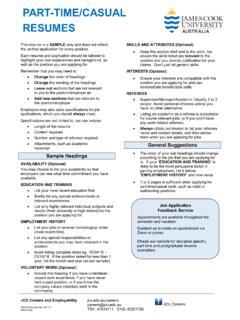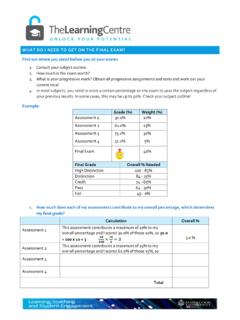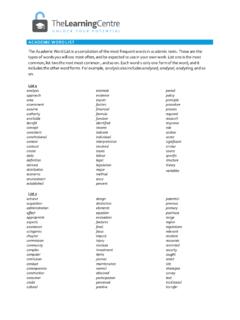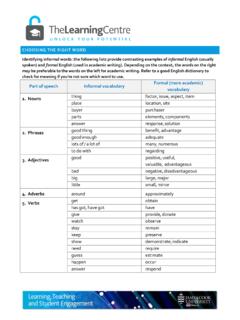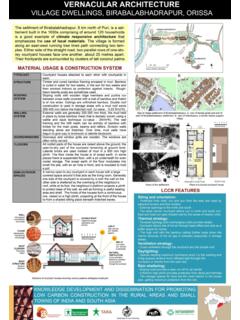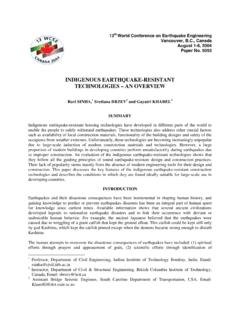Transcription of The Birth of the CTS - James Cook University
1 The Birth of the cyclone Testing Station Personal Recollections George Walker 2007 Prepared as a Contribution to the 30th Anniversary Celebrations of the Founding of the Station in November 1977 The Birth of the cyclone Testing Station George Walker - 2007-08-18 2 In The Beginning In 1958 the North Queensland town of Bowen was hit by its first cyclone in 76 years. It caused major damage. A young Sydney architect, Kevin Macks, had just joined an architectural practice in Townsville and became involved in some of the reconstruction. He settled in Townsville and subsequently formed his own architectural company practicing throughout North Queensland. He never forgot the destruction he had observed in Bowen and was determined that the lessons he had learned then about cyclone resistant building practice should become an integral part of construction in cyclone prone North Queensland. In 1960 following representations from a body of citizens in Townsville calling themselves the Townsville University Society the Queensland Government established the University College of Townsville as a provincial campus of the University of Queensland.
2 It enrolled its first students at the beginning of 1961 including a group of first year engineering students in its Department of Engineering headed by a young hydraulic engineer, Kevin Stark, who had been working on the construction of the Tineroo Dam on the Atherton Tablelands. The initial intention was to provide first and second year courses before transferring the successful students to Brisbane to complete their courses, but Kevin Stark successfully argued that with help from local professionals and visits from Engineering staff at the University of Queensland the full 4 year Civil Engineering course could be provided in Townsville. In 1962 he engaged a young structural engineer, Baden Best, who had been a colleague on the Tineroo Dam, to be responsible for the development of the structural engineering component. In 1963 he engaged Kevin Macks to take the 3rd year course in building construction and architecture . In 1964 a relatively young civil engineering academic from the University of Melbourne, Hugh Trollope, a Welshman by Birth and still in his 30 s who had established the science of geomechanics in Australia, became the first Professor at the University College of Townsville with his appointment as the foundation Professor of Civil Engineering.
3 He was a visionary who believed that the fledgling engineering department could become a major centre of civil engineering research in Australia, with a particular focus on issues relevant to North Queensland, and was determined to see his vision become a reality. It was this somewhat random combination of events that laid the foundation for the establishment of the James Cook cyclone Structural Testing Station more than a decade later. It didn t take long for Hugh Trollope and Kevin Macks to become acquainted. Although an engineer, Hugh Trollope had a strong interest in the relationship between structure and form of buildings. Although an architect, Kevin Macks had a strong interest in the structural engineering behaviour of buildings. Together they were to produce the marriage of ideas from which the cyclone Testing Station was born. In 1970 the University College of Townsville gained its independence as the James Cook University of North Queensland, and in this capacity provided the home for its Birth .
4 The Birth of the cyclone Testing Station George Walker - 2007-08-18 3 A Developing Relationship The University College of Townsville was initially established on a temporary campus adjacent to the Pimlico High School. For its permanent campus the Townsville City Council made a grant to it of over 600 acres at the foot of Mount Stuart in the proposed suburb of Douglas, on which over a period of time permanent buildings were established for the different Departments. The design of the first stage of the Engineering building was commissioned in 1967 with Kevin Macks as the principal architect. In addition to lecture rooms, offices and small laboratories, this phase included two major laboratories, a hydraulics laboratory and a structures laboratory. It was a time when structural engineering research was synonymous with testing large structural components and assemblies, and Hugh Trollope was determined that his Department would have the proper facilities to do this.
5 The funding for the building was insufficient for what he wanted so he approached the Queensland Government Co-ordinator General, Charles Barton, arguing successfully that there was a need for a facility in North Queensland to test full scale bridge beams. In this he had the support of a local consulting engineer, John McIntyre. John McIntyre had come to Queensland from New Zealand as a young civil engineer shortly after graduating from the University College of Canterbury in Christchurch, New Zealand, following studies that had been interrupted by service in the 2nd World War. By the mid 1960 s he was well established as the head of North Queensland s largest local firm of consulting engineers, and was a person of considerable influence within both the engineering profession and the community. Not many bridge beams were tested, but the resulting strong floor facility was to prove invaluable for the testing of building components and sub-assemblies on which the cyclone Testing Station was to be based.
6 A seemingly unrelated event at this time was the appointment of a new staff member. In addition to pioneering the teaching of soil mechanics in Australia, Hugh Trollope played a pioneering role in extending the scope of it to include rock mechanics to produce the discipline known today as geomechanics. His first ambition after arriving in Townsville was to make his new Department the leading centre of rock mechanics research in Australia, recognising its importance in relation to mining activities in northern Australia, and Mount Isa in particular. To get it started he brought with him from Melbourne a young graduate student, Ted Brown, encouraged staff with relevant expertise to join in his endeavour, and in seeking new staff sought staff who may be able to contribute. He had persuaded Baden Best to specialise in the newly developing field of stress analysis known as the finite element method and apply it to the analysis of the behaviour of jointed rock, so when seeking an additional structural engineering academic, he included dynamics in the prescription, with a view to getting someone who may be persuaded to undertake research on the dynamic aspects of rock mechanics.
7 It attracted a young New Zealand engineer working in the United Kingdom in the nuclear power industry who had a PhD in earthquake engineering. The new staff member was George Walker. He never got interested in rock mechanics, but in due course the appointment was also to prove significant in the establishment of the cyclone Testing Station. The Birth of the cyclone Testing Station George Walker - 2007-08-18 4 A Miscarriage By January 1970 Hugh Trollope had achieved his first ambition of establishing a major centre for rock mechanics research in Townsville and was looking for further fields of research in which his Department could excel. Nature answered in the form of cyclone Ada which hit the Whitsunday Islands that month. His response was immediate. Hiring a plane he inspected the damage taking with him George Walker to look at the structural aspects of the damage and Bill Bodley, another staff member, to look at the flood damage, together with Mick Lamont, the University photographer.
8 Dropping Bill off in Proserpine they flew over the Whitsunday Islands and observed the extensive damage, following which a ground inspection of the damage at Airlie Beach was made. (This flight had a worrying moment for Hugh Trollope. Mick Lamont had had the door removed so he could lean out with only his seatbelt restraining him and take his photographs. Anxious to get the best shots he continually urged the pilot to fly slower, until Hugh Trollope observing the stall light flashing on urged the pilot in no uncertain terms to ignore him!) . Before he landed back in Townsville Hugh Trollope had decided here was the next big opportunity to do something unique. As he explained to George Walker, just as the 1960 s had been the decade of earthquake engineering research, of which George was a product, so would the 1970 s be the decade of wind engineering research. Townsville could provide the lead in the study of cyclone resistant housing and other low rise buildings, in contrast to the studies of wind loading on larger buildings which had already begun at the Universities of Sydney and Melbourne.
9 He suggested to George Walker that he become the leader of this research. George Walker was appalled at the thought. Not only did he know nothing about wind engineering, but there did not seem to be a problem requiring research. Roof cladding that peeled off because it was inadequately fastened, roofs that came off concrete block buildings because the cavities containing the tie down rods were filled with cement bags, and houses that disintegrated because they were just nailed together, were all problems that could be easily solved by the application of existing engineering knowledge. What was there to research? Furthermore discussions with Townsville builders indicated that in their opinion the damage had highlighted a problem unique to the Whitsunday Islands. A similar event in Townsville would have much less effect. It needs to be understood that at this time most houses and small low rise buildings were outside the scope of structural engineering except for some particular components like prefabricated roof trusses which were just coming on to the market.
10 Houses were built to prescriptive rules developed by trial and error over time, rules which in Australia were largely embodied in what was known as the Blue Book published by the Commonwealth Bank which described the minimum standards of construction for new houses for which the bank would make a loan. There were special requirements in cyclone areas, mainly regarding the number of cyclone bolts tying the top plate down to the underfloor system - but with few requirements about where they should be located!. Furthermore at this time in Queensland building regulations were the sole preserve of each local Council. Many Councils based their regulations for houses on the Blue Book but interpretations and levels of enforcement varied greatly. The Birth of the cyclone Testing Station George Walker - 2007-08-18 5 When suggestions were made that there were lessons to be learned from cyclone Ada, the house building industry in Townsville reacted negatively, saying the problem was with the local building regulations and their enforcement in the Whitsunday Islands.



